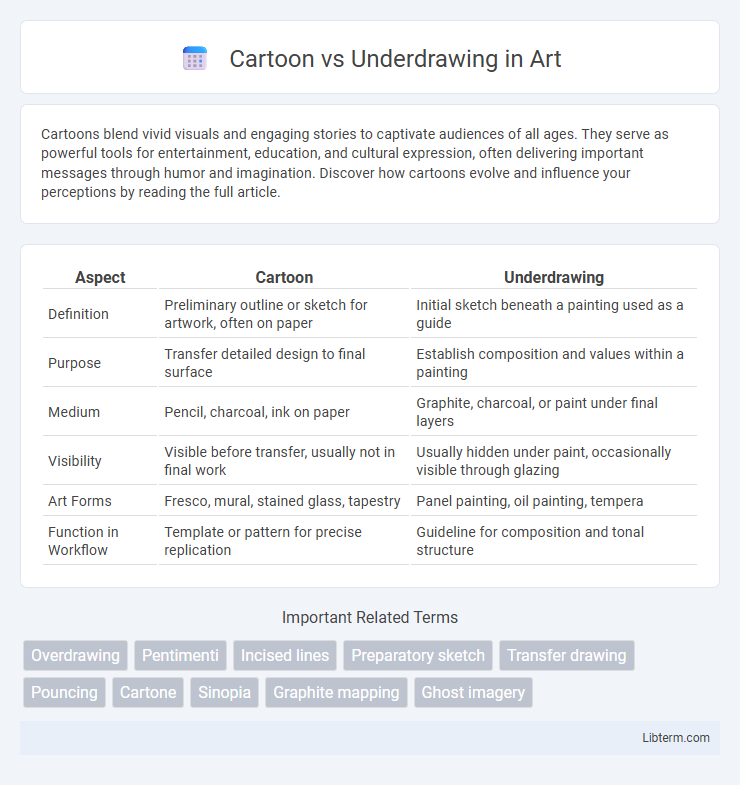Cartoons blend vivid visuals and engaging stories to captivate audiences of all ages. They serve as powerful tools for entertainment, education, and cultural expression, often delivering important messages through humor and imagination. Discover how cartoons evolve and influence your perceptions by reading the full article.
Table of Comparison
| Aspect | Cartoon | Underdrawing |
|---|---|---|
| Definition | Preliminary outline or sketch for artwork, often on paper | Initial sketch beneath a painting used as a guide |
| Purpose | Transfer detailed design to final surface | Establish composition and values within a painting |
| Medium | Pencil, charcoal, ink on paper | Graphite, charcoal, or paint under final layers |
| Visibility | Visible before transfer, usually not in final work | Usually hidden under paint, occasionally visible through glazing |
| Art Forms | Fresco, mural, stained glass, tapestry | Panel painting, oil painting, tempera |
| Function in Workflow | Template or pattern for precise replication | Guideline for composition and tonal structure |
Introduction to Cartoons and Underdrawings
Cartoons are full-scale drawings used as templates for final artworks, often created on paper with clear outlines to guide painting or fresco work. Underdrawings serve as preliminary sketches directly applied to the painting surface, providing an initial composition and structural guidance beneath the final layer. Both techniques play crucial roles in art creation, with cartoons emphasizing detailed planning and underdrawings focusing on foundational layout.
Defining Cartoon in Artistic Practice
Cartoon in artistic practice refers to a full-scale preparatory drawing used as a guide for creating a final artwork, often transferred onto a surface like canvas or fresco. Unlike an underdrawing, which is a preliminary sketch beneath a painting, cartoons are detailed and refined, serving as blueprints for compositions in mural painting, tapestry, and stained glass. The term originated during the Renaissance to describe these comprehensive draft drawings that ensure accuracy and composition before the final execution.
Understanding Underdrawing Techniques
Underdrawing techniques involve creating preliminary sketches that establish the composition and proportions before finalizing artwork, commonly used in painting and illustration. These techniques include using materials like charcoal, graphite, or ink to outline shapes and guide the application of colors and details in the cartooning process. Mastering underdrawing enhances precision and depth, distinguishing it from the more stylized and finalized nature of cartoon art.
Historical Origins of Cartoons and Underdrawings
Cartoons, originating in the Renaissance as full-scale preparatory drawings for frescoes or tapestries, served as essential templates for artists to transfer detailed designs onto final surfaces. Underdrawings, emerging in medieval manuscript illumination and panel painting, functioned as preliminary sketches beneath paint layers to guide composition and correct proportions. Both techniques reveal historical artistic processes, with cartoons emphasizing large-scale design transfer and underdrawings focusing on refined compositional adjustments during painting.
Key Differences: Cartoon vs. Underdrawing
Cartoon refers to a full-scale preparatory drawing used to transfer a design onto a surface, often characterized by clear lines and defined shapes, while underdrawing is a preliminary sketch beneath a painting that guides the artist's composition. Cartoons function as detailed templates for final artwork, commonly found in mural and fresco techniques, whereas underdrawings serve as subtle, often hidden layers that inform the painting process and reveal an artist's adjustments. The key difference lies in cartoons being standalone, public guides in the creative workflow, contrasted with underdrawings that are integral, concealed foundations supporting the final image.
Functions and Purposes in Art Creation
Cartoon serves as a full-scale drawing used to transfer detailed outlines onto a final surface, ensuring precise composition and proportion in artworks like frescoes or tapestries. Underdrawing functions as a preliminary sketch beneath a painting, guiding artists in planning forms, shading, and tonal values before applying paint, enhancing depth and accuracy. Both tools are essential in art creation for maintaining structure and refining visual elements, with cartoons emphasizing layout replication and underdrawings focusing on compositional experimentation.
Materials and Tools Used in Each Method
Cartoon creation often relies on large sheets of paper, charcoal, graphite pencils, and ink pens to produce detailed, scalable sketches that serve as a visual guide for fresco or mural painting. In contrast, underdrawing employs fine, precise tools such as silverpoint styluses, charcoal sticks, or red chalk on primed panels or canvas, providing an initial outline that supports paint application without overwhelming the final artwork. Both methods utilize erasers and sharpeners, but the choice of materials distinctly influences the texture, durability, and visibility of the initial design beneath the painting.
Famous Artists and Notable Examples
Famous artists like Leonardo da Vinci and Michelangelo extensively used underdrawings to plan compositions, visible through infrared reflectography revealing their meticulous preliminary sketches beneath finished paintings. In contrast, cartoons, notably employed by Raphael and the Dutch Masters, function as full-scale preparatory drawings transferred to the painting surface, exemplified by Raphael's "School of Athens" cartoons aiding fresco execution. These distinct techniques highlight the evolution of artistic planning methods, emphasizing precision in underdrawings and compositional accuracy in cartoons.
Impact on Final Artwork and Restoration
Cartoon lines provide clear, bold outlines that define shapes and guide color application, resulting in crisp and vibrant final artwork, while underdrawings offer subtle, structural sketches that lend a more natural, layered complexity. The presence of cartoons facilitates easier restoration by preserving distinct contour information, whereas underdrawings, often faint and delicate, require careful conservation techniques to avoid damage during restoration. Understanding the interaction between cartoons and underdrawings enhances preservation strategies and informs decisions on retouching or cleaning artworks.
Choosing the Right Approach for Your Art
Choosing between cartoon and underdrawing techniques depends on your artistic goals and style preferences. Cartooning emphasizes bold lines and exaggerated features to convey character and emotion quickly, making it ideal for animation and comics. In contrast, underdrawing serves as a detailed foundation for realistic or complex art, allowing precise adjustments before finalizing the piece with layers and shading.
Cartoon Infographic

 libterm.com
libterm.com